1999-2010: A Celebration of Serena’s Career on the Occasion of Her 12th Major
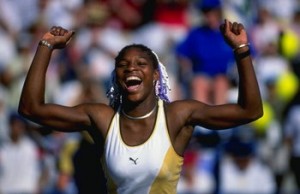
Richard Williams told us it would be so. And Venus predicted her greatest rival would be her sister.
I, for one, discounted all this talk, back in the day. But now it’s been 10 years! Time flies. Serena is a great champion.
So it’s time to take a look back at the years and the moments in Serena’s career.
This is not meant to be a comprehensive review, just a brush up on the times and the significance of Serena’s wins, and a comparison with past champions.
This picture is from Serena’s first appearance at Indian Wells at the age of seventeen, where she defeated Steffi Graf in three sets. It was 1999.
Remember 1999? We were all afraid of the software bug that was going to hit us at the turn of the millennium and destroy the world as we know it.
Song: It’s the End of The World as We Know It [r.e.m.]
For fun, I’ve attached a playlist to this slide show so that you can ‘listen’ in as the times roll by. You’ll need iTunes to take full advantage of that particular feature.
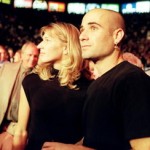
In my memory, 1999 is the year that Andre Agassi won the final leg of his career grand slam. It is also the year that Steffi Graf completed a come-back and won the French Open Ladies trophy.
It is also the year, they both credit, with the development of their romance. This photo shows them together in Sept 1999.
Song: thank God I Found You [mariah carey]
The 1990s – Monica Seles & Steffi Graf
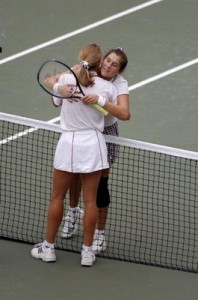
The 1990s in Women’s tennis was defined by the rivalry between Monica Seles and Steffi Graf.
In many ways, Moncia Seles was the ‘mother’ of contemporary women’s tennis with her aggressive style. She grunted with effort.
Serena Williams has talked about Ms. Seles being the inspiration and model for her own tennis.
“At her peak, Monica had unbelievable power, unique strokes, unrivaled determination, and very few errors. She was the most exciting woman to watch.” So said a reader (recently) at a popular sports blog.
Steffi Graf has been talked of as the greatest tennis player of all time—certainly the greatest ladies’ champion of all time—racking up 22 major singles titles, the second most majors of any champion in the Open Era, male or female.
Some have questioned whether, had history unfolded differently, and Monica Seles not been stabbed in 1993—on court in a malicious and heinous act, if Stefft Graf would have won all those titles. Monica Seles was her most significant rival, and was never the same player after the stabbing.
Other women’s champions of the era include Martina Hingis and Jennifer Capriati.
The picture shows Monica Seles and Steffi Graf on Sept. 9, 1995 after Graf had beaten Seles to win the 1995 USO championship.
Song: We are The Champions [queen]
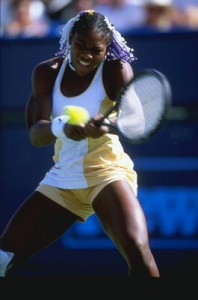
1999: Indian Wells and Serena vs Steffi
Though we usually think of 1999 as the year that Serena became the first African America woman to win a tennis major since Althea Gibson in 1958, when she won the U.S. Open. (A list of Serena’s wins each year will be found at the bottom of each slide.)
In retrospect, the seminal match of the year might have been Serena’s win over Steffi Graf at Indian Wells in the spring—at the age of 17!
Steffi was at the height of her powers—she would go on to win the FO in 1999—her last major title, and Serena would win the 1999 USO—her first, at the age of 18.
We fans love to think about fantasy matchups, and endlessly speculate about the single match of Roger Federer against legend Pete Sampras (2001 Wimbldon, QF).
Here on YouTube you can see a scratchy version of the real thing on the ladies’ side. You’ll notice the standard Serena intensity, drive, ambition, and self-belief.
Song: 1999 [prince]
YouTube of Serena/Graf:
Slam count: 1
Major Matches of 1999
• AO [lost 3rd round]
• FO [lost 3rd round]
• Wimbledon [lost in the 3rd round]
• USO [winner over Hingis]
• Indian Wells final [winner over Steffi Graf]
• Miami [vs Hingis in semi-final, Venus in final]
• 1999 YEC final [winner over Venus]
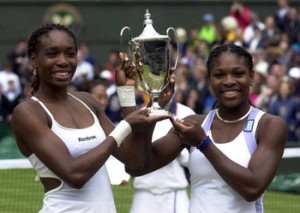
2000: Wimbledon semis
In the early days, the Williams’ sister’s style suffered (by comparison to the subtleties of the men’s game) with a sole reliance on baseline power. Venus had a powerful serve, that would improve in years to come, but neither sister moved much from the baseline.
Both of them would be successful with this approach, beating the likes of Hingis, Davenport, and Seles.
In 2000, on her way to her first Wimbledon title, Venus would defeat Serena in the Wimbledon semi-final, but together they would win the doubles title—the first of many.
Song: American Woman [the guess who]
Cumulative Slam count: 1 (steady)
Major Matches of 2000
• AO [lost in 4th round]
• FO [dnp – injury]
• Wimbledon [lost semi-final to Venus]
• USO [lost QF to Davenport]
• Olympics Doubles Gold Medal
Sept. 11, 2001
For most of us, Sept. 11, 2001 is a day that is indelibly ingrained in our memories.
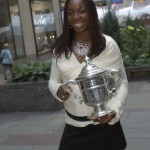
This photo is from Sept. 10, 2001. In New York. Venus had just defeated Serena in the first ever Ladies’ final in a Grand Slam event in the Open Era to be contested by sisters.
As many of their finals have been, this first of their meetings in a Slam final was awkward, with Serena nervous and intimidated. That situation would change.
Song: Fallin’ [alicia keys]
Cumulative Slam count: 1 (steady)
Major Matches of 2001
• AO [lost QF to Hingis]
• FO [lost QF to Capriati]
• Wimbledon [lost QF to Capriati]
• USO [lost the final to Venus]
• Indian Wells final [Venus retired minutes before the final, drawing calls that they had ‘fixed’ the final]
• Roger’s Cup [vs Seles in semi, and Capriati in final]
• USO [vs Henin in 4th rnd, Davenport in QF, and Hingis in semi]
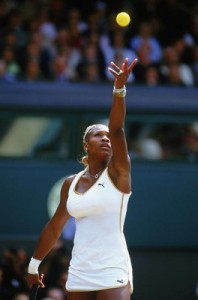
2002 saw Serena commence what may be the greatest triumph of her career – the self-styled ‘Serena Slam.’ Beginning with the 2002 FO, Serena completed the Career Grand Slam by winning the next four major titles. Ironically, the finalist she faced in each championship match was her sister, Venus.
Serena’s other rivals in this timeframe included: Hingis, Henin, Davenport, Capriati. There would be more to come.
In the early part of the century we saw the first, in the form of Anna Kournikova, of many Russian ladies making a name for themselves in the sport of tennis. (The Williams’ sisters played a doubles pair, including Ms. Kournikova, in the 1999 doubles final pictured on a previous slide.)
Like the Williams’ sisters, who were originally from Compton, CA, many Eastern European sports stars would use tennis as an avenue for success.
Ms. Kournikova was a break-through for Russian tennis. Unlike the case of the Williams’ sisters, on her heels would come many ofSerena’s future rivals, including one who would be one of Serena’s biggest competition.
Song: Lose Yourself [eminem]
Cumulative Slam count: 4 increased by: 3
Major Matches of 2002
• AO [ret]
• FO [Winner over Venus]
• Wimbledon [winner over Venus]
• USO [winner over Venus]
• Scottsdale [vs Hingis in semi, and Capriati in final]
• Miami [vs Capriati in QF, Venus in semi, and Hingis in final]
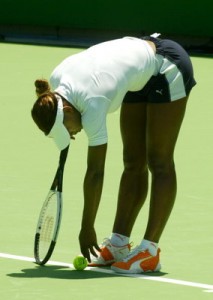
2003: Surgery after Completing the Serena Slam
Serena would be the ninth player in history to accomplish the Career Grand Slam, male or female. In the men’s tour, only three players have accomplished it [Roger Federer is the fourth, as of 2009].
The ball striking and shot making of both Venus and Serena had improved. In the Wimbledon final , several extraordinary rallies that exceeded 16 shots and (though Venus played with a strained stomach muscle), breaks of serve on both sides took place in hard fought games.
Serena would have surgery after her Wimbledon win, and lose her No. 1 ranking until 2009.
Many wondered if the ‘Serena Slam’ would be the highlight of Serena’s career. Especially with the maturing of rival, and world No. 1, Justine Henin.
Song: Can’t Hold Us Down [christina aquillera featuring lil’ kim]
Cumulative Slam count: 6 increased by: 2
Major Matches of 2003:
• AO [winner against Venus – match length 2.5 hours]
• FO [loss to Henin in semi-final – where she accused Henin of poor sportsmanship]
• Wimbledon [winner against Venus]
• USO [dnp – surgery]
• Wimbledon semi-final vs Henin
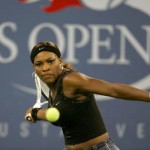
2004: Murder
Serena and Venus’ sister, Yetunde, was brutally shot on Sept. 15, 2003 while talking to a friend in a car in their old neighborhood in Compton, CA.
In a poignant moment forever recorded in the annals of television, Yetunde can be seen in the player’s box in the 2003 final at Wimbledon (July, 2003), and Venus ‘shouts out’ to Yetunde during the post-match interview.
Bereavement—overcoming the sense of tragedy and loss in death—requires incredible reserves of mental strength, and varies from individual to individual. Bereavement requires even more when the death involves a senseless, brutal, and untimely murder.
Venus and Serena have both spoken of how shocked and moved they have been by their sister’s murder. Serena would say her 2007 AO victory was inspired by Yetunde.
Coming back from surgery in 2004, Serena would lose in the majors until Wimbledon, and not play many other tournaments.
Of note: Serena would lose the 2004 Wimbledon final to the Russian woman who succeeded Kournikova in popularity in the tennis world, Maria Sharapova.
Song: Breaking the Habit [Linkin’ Park]
Cumulative Slam count: 6 steady
Major matches of 2004
• AO [dnp – surgery]
• FO [lost in QF to Capriati]
• Wimbledon [lost the final to Maria Sharapova]
• USO [lost in QF to Capriati]
• 2004 YEC [lost the final to Maria Sharapova]
• Olympics missed because of injury
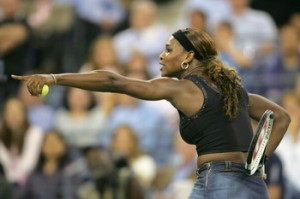
2004: Serena and the Invention of Hawkeye
It was a critical erroneous line call against Serena in the 2004 US Open (against Jennifer Capriati in the quarter-finals) that initiated an industry-wide consideration of a new autonomous, technical, line-calling assistance protocol that was based upon the physics of the flight of the ball, and a system of cameras installed all around the stadium.
Instant replay at the time on television showed the call to be wrong. The line call was so egregious that chair umpire Mariana Alves was later dismissed from the tournament.
Serena continued to play, without a huge display of histrionics, and lost in due time to Capriati.
Five years later, it is hard to imagine the game without Hawkeye. It has taken away the players being victimized by bad line calls.
Players and fans alike can concentrate on tennis.
But the game continued to move on. Rather than diminish the ‘box’ that players try to hit near the corners, five years later, that box has expanded as players use ever more powerful and top-spin heavy strokes to move their opponents out of position (players are out in the doubles alley more an more to return balls).
Nevertheless, Hawkeye is now an indelible part of the game.
This picture is from the 2004 USO quarter-final match with Jennifer Capriati. Look at this body language!
Song: American Idiot [green day]
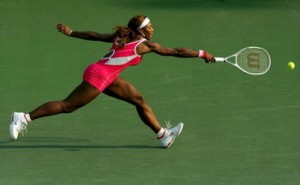
2005: The Sister Matchups are Getting Better
In spite of surgery, bereavement, and spotty opportunities for match play, Serena’s game continued to mature and round out.
In a great match-up in Miami with Venus, with superb quality of hitting—ground strokes in which placement, painting the lines, hitting the corners, use of drop shots, and no longer reliance on pushing the opponent out of position with power, illustrated the fact that both sister’s games were becoming more nuanced.
Song: Pump It [black eyed peas]
Cumulative Slam count: 7 increased by: 1
Major Matches of 2005
• AO [winner against Lindsay Davenport]
• FO [dnp – ankle injury]
• Wimbledon [lost 3rd round]
• USO [lost 4th round to Venus]
• AO [semi vs Sharapova]
• Sony Ericsson Open (Miami) [loss to Venus]
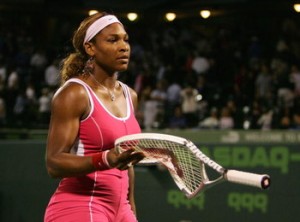
2005: Serena the Saint
Never lacking for passion, Serena often smashed rackets in this stage of her career, and yelled when shots went astray.
A hard-hitting personality, Serena can be hard on her rackets, and on her opponents. Her lapses of grace are many. Serena is notorious for failing to acknowledge when a rival plays well, once claiming that there was nothing her opponent had done right to win the match—she might have had a few ‘lucky shots’ [Justin Henin].
We all have our favorite Serena sayings—words that make us cringe. Including an infamous meltdown in the 2009 USO in which she suggested, to a line judge calling a foot fault on the penultimate point, that she would like to put the tennis ball down her throat until she choked to death (using phraseology for which she would be heavily fined).
But when she lost to Venus in the final of Wimbledon, 2008, and stomped off the court (metaphorically) just as she did in every other loss, many observers noted that her demeanor appeared to be the result of loss, rather than an attitude directed at her opponent. (In other words, she treats all her opponents the same).
Great champions show us what it takes to be great competitors. The mental strength, the determination, the attacking mentality, the self-belief may seem callous and self-serving, while on other hand, they are sometimes characteristic of competitors.
It was Jimmy Conners, the great competitor, who once noted that he hadn’t ‘lost’ a match, he’d just run out of time.
Song: (You’ll Never Make a) Saint of Me [rolling stones]
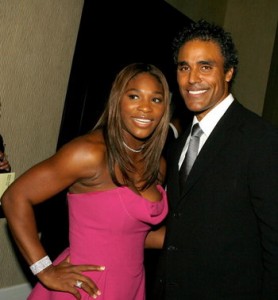
2006: Injury and Enuie
Serena played only four tournaments in 2006.
Surgery kept her out of most of the premier tournaments of the year.
Picture shows Serena with Rick Fox (New York Knicks). For those of us who follow these things, in 2006 Mr. Fox had long since finalized his divorce from singer/actress and beauty queen Vanessa Williams (unrelated to Venus and Serena).
Song: Boulevard of Broken Dreams [diana krall]
Slam count: 7 steady
Major Matches of 2006
• AO [lost 3rd round]
• FO [dnp]
• Wimbledon [dnp]
• USO [loss 4th round]
2007: Ranked 81 and winning the AO
In what might be the second (or first, depending upon how you look at it) greatest triumph of her career, Serena became the lowest ranked woman to win a Slam in the history of tennis, defeating rival Maria Sharapova in the process.
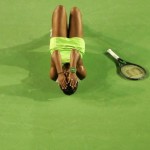
Her performance in the final was described as “one of the best performances of her career” and as “arguably the most powerful display ever seen in women’s tennis.”
Serena would dedicate her 2007 AO victory to slain sister Yetunde.
In 2007 Serena would come up against perhaps her greatest rival in Justin Henin—someone she dominated in the early stages of her career, but who clearly eclipsed Serena in 2007.
“Justine gave me fits,” Serena would say.
We can only speculate how this great rivalry would have shaped the history of the women’s game, with a resurgent Serena Williams, as Ms. Henin retired abruptly in the second quarter of 2008.
Song: Not Too Late [nora jones]
Slam count: 8 increased by: 1
Major Matches of 2007
• AO [winner over Maria Sharapova]
• FO [dnp]
• Wimbledon [loss to Henin in QF]
• USO [loss to Henin in QF]
• Sony Ericsson Open (Miami) defeated Sharapova in fourth round
• Sony Ericsson Open (Miami) defeated Henin in semi
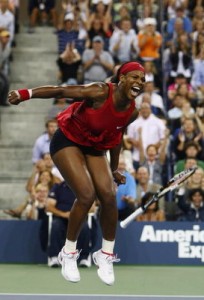
2008: Fantastic Form
The many great matchups in 2008 included yet another final clash with sister Venus at Wimbledon, the best yet. The match was of the highest quality, with Serena loosing in a tie-break in the third set.
But perhaps the finest matchup of the year was a quarter final with Venus at the USO which was contested in two tie-breaks 7–6(6), 7–6(7). Serena defeated Venus after saving a total of 10 set points!
Serena looked different, calmer, more centered, than ever before (exuberant in victory, of course).
She started using a Nadal-like ‘buggy-whip’ finish to some of her ground-strokes to improve the top-spin, and her serve had long since been one of the most feared of tennis weapons. And she started borrowing technique from Pete Sampras on her serve.
Song: Cyclone [baby bash]
Slam count: 9 increased by: 1
Major Matches of 2008
• AO [lost to Jankovic in QF]
• FO [3rd round loss]
• Wimbledon [finalist against Venus]
• USO [winner, defeating Venus in QF]
• Olympics Doubles Gold Medal
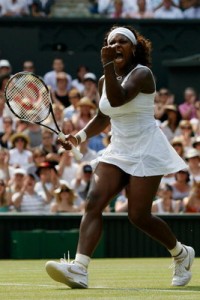
2009: Can Serena go 3 for 4?
Serena only played three tournaments by July, 2009! She played in and won two of the first three of the year’s majors! She did not complete, due to injury, any of the early WTA Championship Series tournaments of 2009.
In spite of spotty play, her form has never looked better, as she played one of the finest (and longest) ladies semi-final matches at Wimbledon against Elena Dementieva.
The hitting in this match was of a very high quality: volleys, drop-shots, groundstrokes painting the lines, short points won on serve, and lengthy rallies.
The No. 1 ranking would be held by ladies’ champions who were more consistent on the tour in the smaller tournaments: Anna Ivanovic; Jalena Jankovic; and Dinara Safina.
But in the spring, former world #1, Kim Clijsters would announce her return to the game, and by the end of summer, 2009, Kim would make a successful run at the USO. On the eve of earning a 12th major, Serena would have one of those emotional meltdowns that would live in infamy, be faulted on match point, and lose the semi-final to Clijsters. Serena would be fined close to $100K for her on-court behavior following a foot-fault call.
Song: Nuthin’ But A ‘G’ Thang [dr. dre]
Slam count: 11 increased by: 2
Major matches of 2009
• AO [winner over Azarenka]
• FO [lost QF to Kuzneskova]
• Wimbledon [winner in a final with Venus]
• USO [lost SF to Clijsters & The ‘Incident’ with the lineswoman]
• Wimbledon [outstanding semi-final with Dementieva (shown here)]
• WTF [winner, including two matches with Venus]
2010: Tied with the Legends!
Inspired by the return of Kim Clijsters who should announce her return to the game? None other than one of Serena’s greatest rivals, Justine Henin! She of the gorgeous backhand, of nimble feet and small size who hit well above her weight.
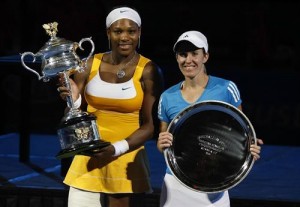
On only her second tournament appearance in her ‘second career’, Henin would make an unlikely, but successful run at the 2010 AO, and find herself facing Serena in the final for the Daphne Akhurst Memorial Trophy.
While Serena has had lapses in her career where the unforced error count was high, and her form dipped dramatically, since 2008, her focus has seemed laser-like, and her form never better. For twelve months or more, Serena, with a Sampras-esq ability, was exhibiting superb form on serve as well as retrieving. No female on the tour, and few men, serves better, with accuracy (all the corners) and pace.
Serena defeated Henin in three magnificent sets to obtain a twelfth major title.
Song: Single Ladies (Put your hands up) [Beyonce]
Slam count: 12 increased by: 1 as of Jan 30
Major matches of 2010
• AO [winner over Henin]
• TBD
Summary
Congratulations, Serena, on the achievement of your 12th major title. Serena will go down as one of the sports all time greats. She is now tied with some of the legends of the sport – women who have their names written on the stadium: Suzanne Lenglen, and Billy Jean King. And her career is not over.
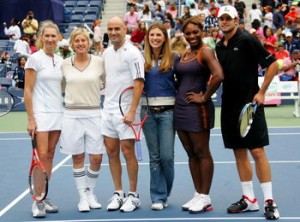
She’s had challenges, particularly with her sister’s death in 2003, but her drive, ambition, self-belief, desire on court, and willingness to attack, are almost the definition of what it takes to be a champion.
Great champions are measured by their competition. Serena has played against, and beaten, some of the finest women’s champions in the history of the game—including her sister, Venus, with whom she has recorded not only the most wins, but also the most even record!
Serena’s head-to-heads (h2h) against these women are included below (with apologies if matches are missing in this account)!
Graf [1999 Sydney; Indian Wells (Graf would win the FO, then retire a few months later)] h2h: 1-1
Seles [1997: Chicago; 2001: Roger’s Cup] h2h: 2-0
Hingis [1998: Miami; 1999: Miami; USO; 2001: AO, Roger’s Cup (ret), USO; 2002: Scottsdale, Miami] h2h: 5-3
Capriati [2001: FO, W, Roger’s Cup; 2002: Scottsdale, Miami, Rome, FO; 2003: Miami; 2004: USO] h2h: 6-3
Davenport [1999: IW USO, Munich; 2000: LA; 2001: IW, Munich, USO; 2002: LA; 2004: LA; 2005: AO] h2h: 9-1
Sharapova [2004: W, YEC; 2007: AO] h2h: 2-1
Henin [2001: USO; 2002: Qatar, Berlin, Rome; 2003: W, Charleston; 2007: FO, W, Miami; 2010: AO ] h2h: 6-4
Venus [1998: AO, Miami; 1999: Miami; 2000: W; 2001: IW, USO; 2002: Miami, FO, W, USO; 2003: AO, W; 2005: Miami; 2008: W, USO; 2009: W, WTFx2] h2h: 13-10
She has won each major except the FO multiple times over.
AO [2003, 2005, 2007, 2009, 2010]
FO [2002]
Wimbledon [2002,2003, 2009]
USO [1999, 2002, 2008]
Unlike many men’s champions, her record in the WTA Championship Series is not stellar, with three wins (compare with the ATP Master’s Series: Andre Agassi at 17, Roger Federer at 16, and Rafael Nadal at 15).
But she may have extended her career with judicious timing of when and where to play her best tennis. Her management of her career, rather than a liability, may be considered a model for other players.
Finally, Serena even counts wins over her male contemporaries in her repertorie. In this 2008 interview, Serena talks about her 1990 win over Andy Roddick, when she was 10 (very funny, about 1 minute long).
Song: I’m Every Woman [whitney houston]
The picture shows Steffi Graf, Andre Agassi, Ellen Degeneres (comedienne), Serena and Andy Roddick at the 2006 Arther Ashe ‘Kids Day’ charity function to kick off the USO.
YouTube of Andy Roddick:

This is one major piece of work, and a timely reminder of the legacy of Serena.
I favour the playing style of Justine, of Steffi and even of Venus, but that is not to deny the supreme athleticism of Serena, her focus, her desire, her power, the beauty she brings to the tennis court.
I'd forgotten how much time she missed through surgery. I worry about just how much strapping she carries now. But then she seems to manager her fitness and schedule so well, I'm sure she's got it all under control.
Wonderful and complex resume…
Yes, Justine, like Roger, has the most beautiful game in the sport! such a pleasure to watch. I expect to enjoy her matches in encore form of Dementieva, Wickmayer, from this tournament for many months to come, for the elegant and beautiful tennis.
Took me a long time to appreciate Serena for what she brings to the sport. And, personally, I believe that both Williams' sisters are playing much more versatile and diverse tennis than they did when they started out. They were hard to watch when they started out, and I don't know how many times I wanted them to get a new coach. Henin, in particular, played a much more all-around game.
Starting in 2008, Serena's tennis has exploded in terms of being multi-dimensional. I think she is doing two things – copying Pete Sampras on serve, and Rafa Nadal on topspin. Now I can only marvel at her serving prowess. Perfect example is this final with Henin. Pete Bodo over on TEnnis.com even wrote that a player lives and dies by the serve; serving trumps a ground-game every time; and Serena's match-ups with Henin will be characterized by that key difference as long as Henin's serving is as poor as it is now.
One of the things I marvel at is how Serena has improved in that area. It speaks to about attitude when you can decide to adopt other players techniques into your game. She identified the places where her game needed to improve over what it was in 2004; 2005; 2006, and she did it.
Wow – this is major! A very comprehensive overview of the legacy of Serena Williams who is on her way to equal the really big time names at the top like Martina and Steffi! Who knows – she may make it. She seems unbeatable on the big stages – even taped up she dominated down under! Great, great job!!
Hey! Thanks for the Blog ! I found it insightful with some research I’m doing right now. I’m going to bookmark this post and return. can you tell me where i can find more information on this? Keep it up!
Hi im looking for a good
Very wonderful one.